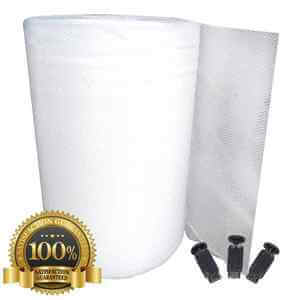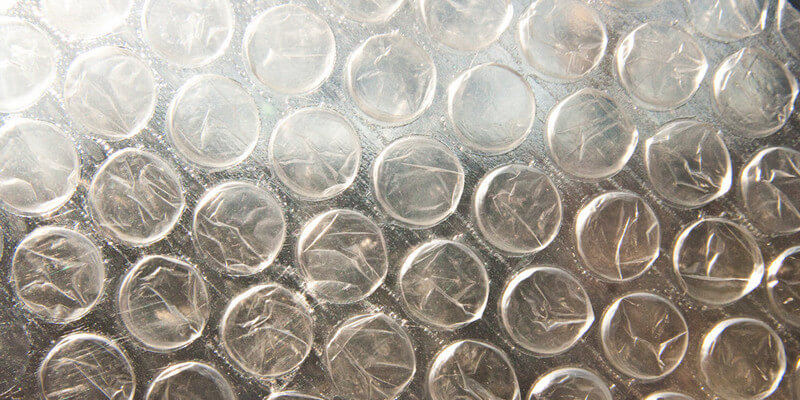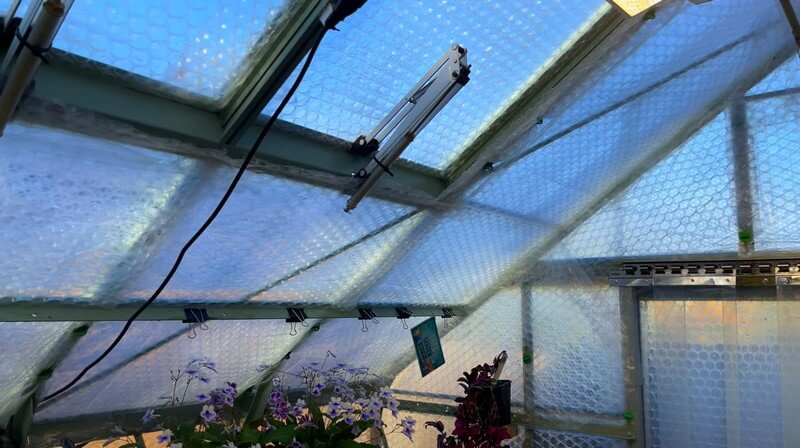Greenhouses are an essential tool for gardeners and plant enthusiasts who want to create an optimal growing environment for their plants. However, maintaining the ideal temperature and humidity levels inside a greenhouse can be challenging, especially in colder climates. This is where greenhouse insulation comes in. In this article, we will explore how to use bubble wrap as an insulation material for your greenhouse, its benefits, drawbacks, and how to properly install it.
Is bubble wrap a good insulator?
Bubble wrap is a good insulator because it has an excellent ability to trap air between its layers of plastic bubbles. Air is a poor conductor of heat, meaning that it does not easily transfer heat energy from one place to another. When air is trapped between two layers of bubble wrap, it creates a barrier that significantly reduces the transfer of heat through convection and conduction. This trapped air also reduces the transfer of heat through radiation, as the plastic bubbles reflect radiant heat back into the greenhouse. As a result, bubble wrap has a high R-value, which is a measure of its insulation performance. This makes it an effective insulator for reducing heat loss and maintaining a consistent temperature inside a greenhouse.
Greenhouse Insulation: A Key Factor for Optimal Plant Growth
Greenhouse insulation is an essential aspect of creating a stable and controlled environment for plant growth. A well-insulated greenhouse can help to regulate the internal temperature, maintain consistent humidity levels, and protect plants from harsh weather conditions. Here are some of the key benefits of greenhouse insulation:
- Temperature regulation: Insulating your greenhouse can help to maintain a consistent internal temperature. This is important because plants need a stable environment to grow and thrive. Insulation helps to prevent heat loss during cold weather and reduce overheating during hot weather.
- Energy efficiency: A well-insulated greenhouse can help to reduce energy costs by minimizing the need for heating and cooling systems. Insulation can retain heat during the day and release it slowly at night, reducing the need for additional heating.
- Improved plant growth: Insulation helps to create a stable environment for plant growth by regulating temperature and humidity levels. This can result in better yields, healthier plants, and a longer growing season.
- Protection from weather conditions: Insulation can help to protect plants from harsh weather conditions such as frost, wind, and rain. This can help to extend the growing season and increase yields.
- Pest control: Insulated greenhouses can help to prevent pest infestations by creating a barrier against insects and other pests. This can help to reduce the need for chemical pesticides and promote natural pest control methods.
Benefits of Using Bubble Wrap for Greenhouse Insulation
Bubble wrap is a popular and low-cost option for greenhouse insulation, thanks to its many benefits. Here are some of the advantages of using bubble wrap:
- Low cost: Bubble wrap is an affordable insulation solution compared to other materials like fiberglass, polycarbonate sheets, or insulated panels.
- Easy to install: Bubble wrap is easy to handle and can be quickly cut and attached to the greenhouse frame, making it a great DIY option.
- High insulation value: Bubble wrap has a high R-value, which means it provides excellent insulation against heat loss and can help maintain a consistent temperature inside the greenhouse.
Drawbacks of Using Bubble Wrap for Greenhouse Insulation
While bubble wrap is an effective insulation material, it does have some drawbacks that you should consider before deciding to use it. Here are some of the limitations of using bubble wrap:
- Durability concerns: Bubble wrap is not the most durable material, and it can deteriorate quickly under direct sunlight or extreme weather conditions.
- Limited lifespan: Bubble wrap is not a permanent solution, and it will need to be replaced periodically.
- Potential for reduced light transmission: Bubble wrap can reduce the amount of light that enters your greenhouse, which can negatively affect plant growth.
Elixir Gardens Greenhouse Bubble Insulation Wrap – Best Bubble Wrap for Greenhouse

Elixir Gardens Bubble Wrap is a high-quality insulation product designed to regulate temperature, protect plants from harsh weather conditions, and extend the growing season. With a thickness of 10mm and a width of 750mm, this bubble wrap insulation comes in a variety of sizes ranging from 2m to 60m, making it suitable for use in both small and large greenhouses.
One of the key features of this product is its UV resistance, which ensures long-lasting performance even when exposed to direct sunlight. Additionally, this bubble wrap insulation provides frost protection, which can help to prevent damage to plants during cold weather conditions.
Elixir Gardens Greenhouse Bubble Insulation Wrap can extend the growing season by up to 6 weeks, allowing for a longer period of plant growth and increased yields. It can also help to start the new season by up to a month, giving gardeners a head start on their planting.
This product is designed to last several seasons and is easy to install with the included fixing clips. By using Elixir Gardens Greenhouse Bubble Insulation Wrap, gardeners can create a stable and controlled environment for their plants, ensuring optimal growth and yield.
How to Install Bubble Wrap for Greenhouse Insulation
Now that you know the benefits and drawbacks of using bubble wrap for greenhouse insulation, let’s explore how to install it. Here are the steps to follow:
- Measure the dimensions of the greenhouse: Before cutting the bubble wrap, you need to measure the dimensions of the greenhouse to ensure you have the correct amount of material.
- Cut bubble wrap to size: Use a sharp pair of scissors or a utility knife to cut the bubble wrap to the required size.
- Attach bubble wrap to the greenhouse frame: Using greenhouse clips or adhesive tape, attach the bubble wrap to the greenhouse frame. Make sure to leave some space for ventilation and to avoid sealing the greenhouse completely.
To get the best results, make sure to install the bubble wrap tightly and securely, but without creases or gaps that could let cold air in. Also, consider using double-layered bubble wrap or UV-protected bubble wrap for added insulation and durability.
Why standard packaging bubble wrap is a BAD choice for greenhouse insulation
While standard packing bubble wrap may seem like an attractive option for greenhouse insulation due to its low cost and wide availability, there are some reasons why it may not be the best choice.
Firstly, standard packing bubble wrap is typically not designed for long-term outdoor use. It may become brittle and break down over time when exposed to sunlight and extreme temperatures, resulting in reduced insulation performance.
Secondly, standard packing bubble wrap may not have the necessary thickness or density to provide effective insulation in a greenhouse environment. It may not be able to maintain a consistent temperature inside the greenhouse, which can be detrimental to plants and crops.
Lastly, standard packing bubble wrap may not be as safe or environmentally friendly as specially designed greenhouse bubble wrap. It may contain harmful chemicals that can leach into the soil or be toxic to plants, and it may not be recyclable.
Frequently Asked Questions
How long will bubble wrap last as greenhouse insulation?
The lifespan of bubble wrap as greenhouse insulation depends on various factors such as exposure to direct sunlight and extreme weather conditions. On average, bubble wrap insulation can last for one to two seasons before needing to be replaced.
Will using bubble wrap reduce the amount of light in my greenhouse?
Yes, bubble wrap can reduce the amount of light that enters your greenhouse. However, this can be minimized by using clear or UV-protected bubble wrap, and ensuring that the bubble side faces outwards to avoid blocking too much light.
Can I use bubble wrap for both walls and roof insulation?
Yes, bubble wrap can be used for both wall and roof insulation. However, you should make sure to leave enough space for ventilation and to avoid completely sealing the greenhouse.
Can I reuse bubble wrap from packages as greenhouse insulation?
Reusing bubble wrap from packages as greenhouse insulation is possible, but not recommended. The insulation value of used bubble wrap may not be as effective, and there is a risk of damaging the bubble wrap during the removal process.
How does bubble wrap insulation compare to other insulation options?
Bubble wrap insulation is a low-cost option compared to other materials like fiberglass, polycarbonate sheets, or insulated panels. However, it is not as durable and long-lasting as some of these materials and may need to be replaced more frequently. It also has a lower insulation value than some of the more expensive options. Ultimately, the best insulation choice for your greenhouse depends on your specific needs and budget.
Conclusion
In summary, bubble wrap is an effective and low-cost insulation solution for your greenhouse, provided you take into account its benefits and drawbacks. It is easy to install, has a high insulation value, and is a great DIY option. However, it is not the most durable material and can reduce light transmission. By following the steps outlined above, you can properly install bubble wrap for your greenhouse insulation and enjoy a consistent and comfortable growing environment for your plants.


